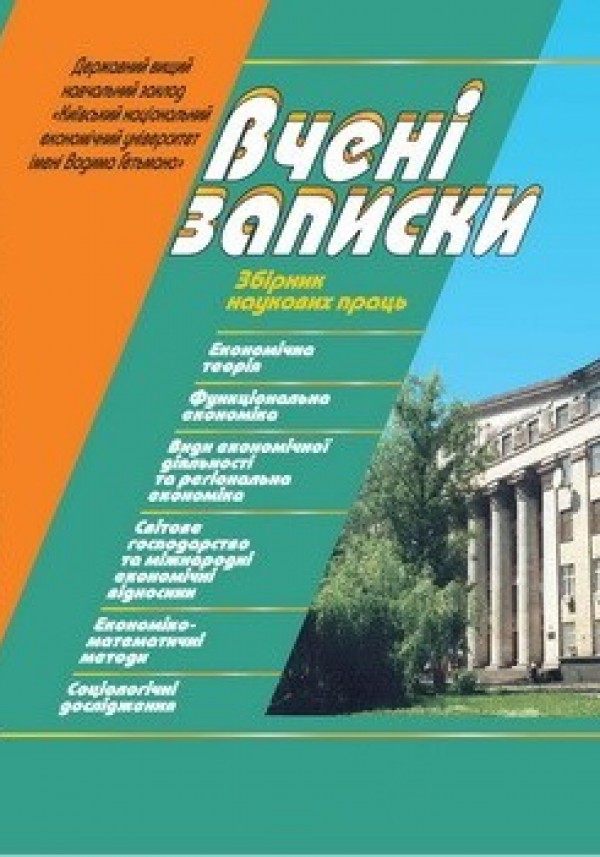
Collection of Scientific Papers "Scientific Notes"
ISSN 2415-8518
Конкурентна девальвація, як глобальна перешкода узгодженню валютно-регуляторних завдань
Competitive depreciation. a global obstacle to monetary regulatory tasks’ consensus
DOI:
10.33111/vz_kneu.34.24.01.02.012.018
Анотація: На сучасному етапі розвитку світового господарства та міжнародних економічних відносин можливі суперечки щодо завдань валютного регулювання міжнародної економічної діяльності. Такі цілі діяльності національних валютно-регуляторних органів, як сприяння міжнародній конкурентоспроможності національних виробників, можуть суперечити цілям міжнародних валютно-регуляторних організацій. Однією із таких суперечностей можна вважати конкурентну девальвацію, поняття якої визначено, зокрема Статтями Угоди Міжнародного Валютного Фонду. Проблематику конкурентної девальвації, як теоретичного явища, вивчали такі зарубіжні вчені як П. Бергін, Д. Корсетті, Д. Лі, Г. Ліма, Д. МакКомбі, Р. Рібейро, А. Роднянскі, С. Сяо, Л. Танг, Й. Тервала, Ш. Чжоу, серед вітчизняних вчених, чиї праці присвячені зазначеній тематиці, можна виокремити О. Виноградову, В. Голюк, В. Дергачову, М. Кравченко, З. Луцишин, Н. Рєзнікову та інших. У статті проаналізовано сучасні теоретичні засади девальвації національної валюти, як способу впливу на набуття національними виробниками конкурентних переваг на світових ринках. Метою роботи є визначення засад валютного регулювання, на яких державні механізми впливу на національну валютну систему можуть одночасно сприяти набуттю національними виробниками конкурентних переваг на світових ринках та спричинити девальвацію національної валюти. Визначено основні напрями регуляторної діяльності національних органів валютної політики, що потребують модернізації, а саме: механізм регулювання грошової пропозиції з метою сприяння набуттю національними виробниками конкурентних переваг на світових ринках.
Abstract: At the current stage of development of global economy and international economic relations, certain disputes over the goals of regulatory framework on international economic activity may arise. Such regulatory objectives of domestic monetary authorities as promoting the global competitiveness of domestic producers, may contradict the regulatory objectives international monetary authorities. One of such contradictions is competitive depreciation, the concept of which is defined, in particular, by the Articles of Agreement of the International Monetary Fund. The issue of competitive devaluation as a theoretical phenomenon has been studied by such foreign scholars as P. Bergin, D. Corsetti, D. Li, G. Lima, D. McCombie, R. Ribeiro, A. Rodnianski, S. Xiao, L. Tang, Y. Tervala, S. Zhou; among the domestic scholars whose works are devoted to this topic, we can distinguish O. Vinogradova, V. Holiuk, V. Dergachova, M. Kravchenko, Z. Lutsyshyn, N. Reznikova and others. This article analyzes the modern theoretical foundations of domestic currency depreciation as a way to promote gains of competitive advantages on global markets by domestic producers. The purpose of the study is to determine the fundamentals of monetary regulation on which available to monetary authorities mechanisms of influencing the domestic monetary system may simultaneously contribute to gains of global competitive advantages by domestic producers and cause the domestic currency depreciation. The main areas of regulatory activity of domestic monetary authorities that need to be modernized, namely, the mechanism for regulating the money supply in order to facilitate the acquisition of competitive advantages by national producers in world markets have been identified in this article.
Ключові слова: конкурентна девальвація, NOEM, грошова маса, центр-периферичні моделі, світове господарство.
Key words: competitive devaluation, NOEM, money supply, center-periphery models, global economy.
УДК: 339.92
UDC: 339.92
JEL: F30 F33 F41
To cite paper
In APA style
Grona, A. (2024). Competitive depreciation. a global obstacle to monetary regulatory tasks’ consensus. Collection of Scientific Papers "Scientific Notes", 34 (1), 15-22. http://doi.org/10.33111/vz_kneu.34.24.01.02.012.018
In MON style
Грона А.В. Конкурентна девальвація, як глобальна перешкода узгодженню валютно-регуляторних завдань. Збірник наукових праць "Вчені записки". 2024. № 34(1). С. 15-22. http://doi.org/10.33111/vz_kneu.34.24.01.02.012.018 (дата звернення: 29.12.2025).
With transliteration
Grona, A. (2024) Konkurentna devalvatsiia, yak hlobalna pereshkoda uzghodzhenniu valiutno-rehuliatornykh zavdan [Competitive depreciation. a global obstacle to monetary regulatory tasks’ consensus]. Collection of Scientific Papers "Scientific Notes", no. 34(1). pp. 15-22. http://doi.org/10.33111/vz_kneu.34.24.01.02.012.018 (accessed 29 Dec 2025).
.png ) # 34(1) / 2024
# 34(1) / 2024
Download Paper
480
Views
203
Downloads
0
Cited by
- International Monetary Fund. (2020). Articles of Agreement. International Monetary Fund. https://doi.org/10.5089/9781513521244.013
- SDR Valuation. IMF. https://www.imf.org/external/np/fin/data/rms_sdrv.aspx
- Corsetti, G. (2008). New Open Economy Macroeconomics. In M. Vernengo, E. P. Caldentey, J. Ghosh (Ed.). The New Palgrave Dictionary of Economics. Palgrave Macmillan. https://doi.org/10.1057/978-1-349-95121-5_2550-1
- Bergin, P. R., & Giancarlo, C. (2020). Beyond Competitive Devaluations: The Monetary Dimensions of Comparative Advantage. American Economic Journal: Macroeconomics, 12(4), 246–86. https://doi.org/10.1257/mac.20160094
- Tervala, J. (2013). Learning by devaluing: A supply-side effect of competitive devaluation. International Review of Economics & Finance, 27, 275–290. https://doi.org/10.1016/j.iref.2012.10.007
- Kuroda, H. (2013). Quantitative and Qualitative Monetary Easing: Speech at a Meeting Held by the Yomiuri International Economic Society in Tokyo. Bank of Japan. https://www.boj.or.jp/en/about/press/koen_2013/data/ko130412a1.pdf
- Rodnyansky, A. (2017). Essays in Unconventional Monetary Policy and Firm Dynamics [Doctoral Dissertation, Princeton University]
- Bajzik, J., Havranek, T., Irsova, Z., & Schwarz, J. (2019). The Elasticity of Substitution between Domestic and Foreign Goods: A Quantitative Survey. Czech National Bank. https://www.cnb.cz/export/sites/cnb/en/economic-research/.galleries/research_publications/cnb_wp/cnbwp_2019_12.pdf
- Xiao Xiao, Tang Lihua, Zhou Shuzhan, & Li Jie. (2011). A Simple Model for the «China Factor» in a Small Open Economy. In Cheung Yin-Wong, Ma Guonan (Ed.). Asia and China in the Global Economy. (pp. 81–94). World Sclentific. https://doi.org/10.1142/9789814335270_0003
- Ribeiro, R. S. M., McCombie, J. S. L., & Lima, G. T. (2017). Some unpleasant currency-devaluation arithmetic in a post Keynesian macromodel. Journal of Post Keynesian Economics, 40(2), 145–167. https://doi.org/10.1080/01603477.2016.1246949
- Porter, M. E. (1980). Competitive Strategy: Techniques for Analyzing Industries and Competitors. Free Press. https://s3.us-east-1.amazonaws.com/storage.thanksforthehelp.com/qfile/porter-michael-e-1980-extract-competitive-strategy-vyr2a2bw.pdf
- Schwab, K. (2014). The Global Competitiveness Report 2014–2015. World Economic Forum. https://www3.weforum.org/docs/WEF_GlobalCompetitivenessReport_2014-15.pdf
- World Bank Open Data. https://data.worldbank.org/indicator/NE.TRD.GNFS.ZS?end=2022&start=2010
- Bertaut, C., Bastian von Beschwitz, & Curcuru, S. (2023, June 23). The International Role of the U.S. Dollar Post-COVID Edition. Federal Reserve System. https://www.federalreserve.gov/econres/notes/feds-notes/the-international-role-of-the-us-dollar-post-covid-edition-20230623.html

